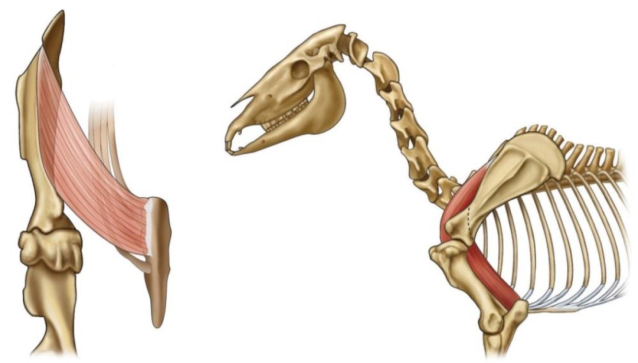|
This is our last week in the pectoral group and we'll wrap it up with the Subclavious muscle as well as some problems and dysfunctions that this group commonly sees. Let's get started!
L O C A T I O N: This muscle is also starts its attachment on the sternum, but also in the cartilage of ribs 1-4. It goes forward and up and actually attaches on the upper part of the front of the scapula. It is a prisms like structure. F U N C T I O N: Aids in suspension of the trunk – assists the serratus ventralis when hoof is on the ground. It is a very important muscle in drawing the forelimb back relative to the body (if no weight is on the leg) or moving the body forward and over a weighted leg. It also pulls the front leg in towards the body. P R O B L E M S: Problems associated with the pectorals begin to arise when any of the muscles in the group lose the ability to work effectively and correctly. This may be a result of injury, compensatory locomotive patterns, sensitivity, hypertonic muscle state to name a few. Dysfunction of the pectorals will impede their functionality. Therefore, protraction, retraction, dorsal and ventral excursion will be limited. Suspension and shock absorbing capabilities associated with the trunk are limited; the trunk can lower, preventing engagement during locomotion… especially with the additional weight of the rider. Decreased shock-absorbing and suspension functionalities can cause chronic and destructive effects to the forelimbs ie. arthritic changes. C O M M O N I S S U S E S O F T H I S G R O U P: Incorrect Equitation: 1. Horse is ridden “upside down” – hollowed back, contracted epaxial musculature, disengaged hypaxial musculature, head and neck position is contracted and behind the vertical or above the bit. 2. Trunk is encouraged into a lower position between the thoracic limbs. 3. Poor epaxial engagement (hollowing & tightening) and restricted head position/nose poking out prevent raising of the trunk back to a neutral position. 4. Strain on the lumbosacral junction can lead to the development of secondary dysfunction, initially presenting as poor hindlimb engagement. 5. This sequence is P A T H O L O G I C A L – the development of a disease. Poor Saddle Fit/Quality/Positioning… 1. Poor placement of the saddle on the horse — the girth does not sit in the natural girth groove, saddle positioned too far forward over the scapula. Poor Girth: 1. The length of the girth — a girth of incorrect length can cause pressure points. 2. The width of the girth — a girth that is too narrow can place increasing amounts of pressure on a concentrated area, eventually having a negative effect on ascending pectoral muscle health and thus functionality. (Does the horse object to the girth being tightened? Saddling up?) Discipline: 1. Disciplines that involve forelimb loading exercises (ie. jumping, high speed locomotion over varying terrains, barrel racing) can place additional stress on the pectorals. 2. Horses at particular risk in this instance are those that are overexerted and/or underconditioned. An Overlooked Primary Issue: 1. Pectoral group dysfunction may occur as a result of a primary issue; making pectoral muscle injury secondary and compensatory. 2. Distal limb/C7-T1 disease can lead to tension of the pectorals for example.
0 Comments
|
Muscle Monday Posts!I'll post all of the Muscle Monday posts from our Facebook and Instagram here so it's a little easier for you to find if you'd like to learn more about your horse's muscles. Archives
October 2021
Categories |
"The real joy in life comes from finding your true purpose and aligning it with what you do every single day." |
"I’ve often said there is nothing better for the inside of the man, than the outside of the horse." |
Copyright 2021
Proudly powered by Weebly

 RSS Feed
RSS Feed
